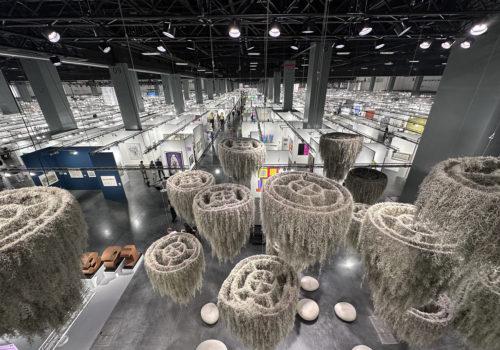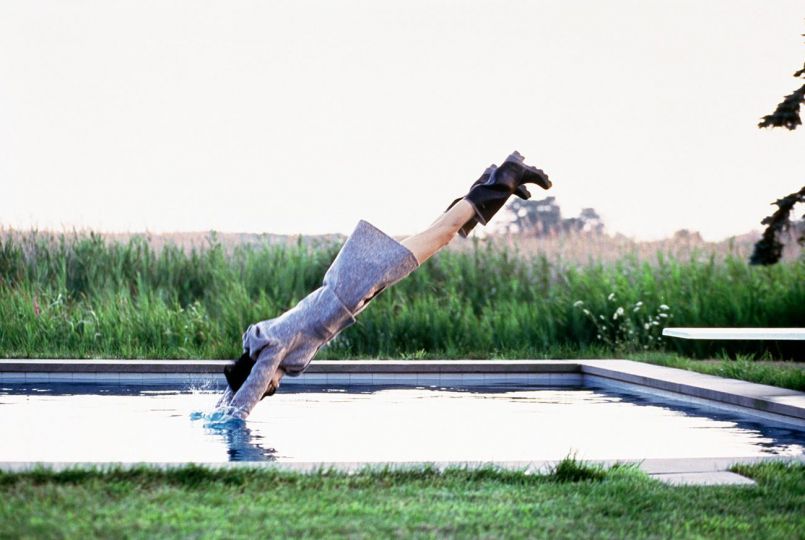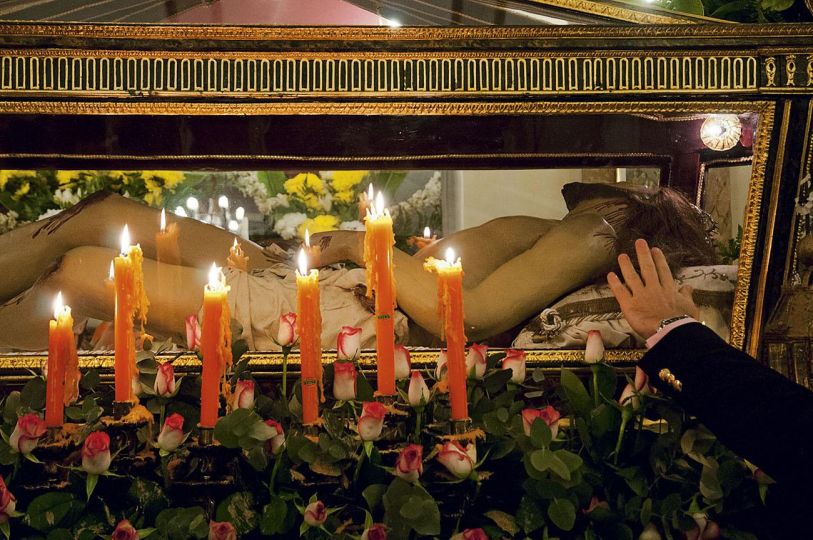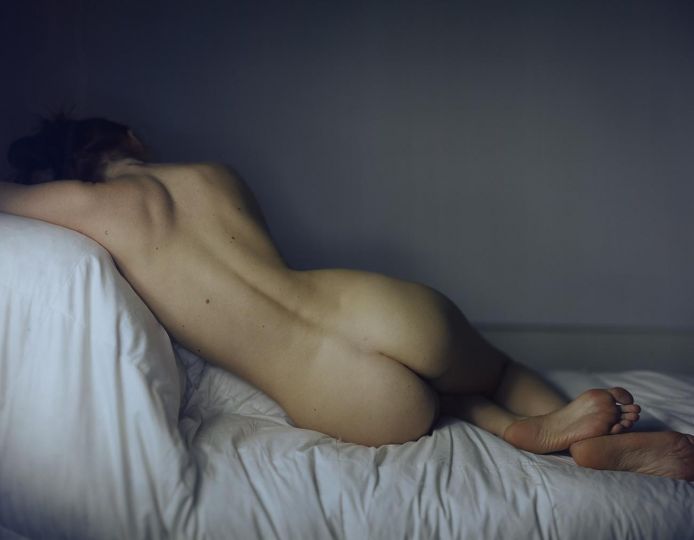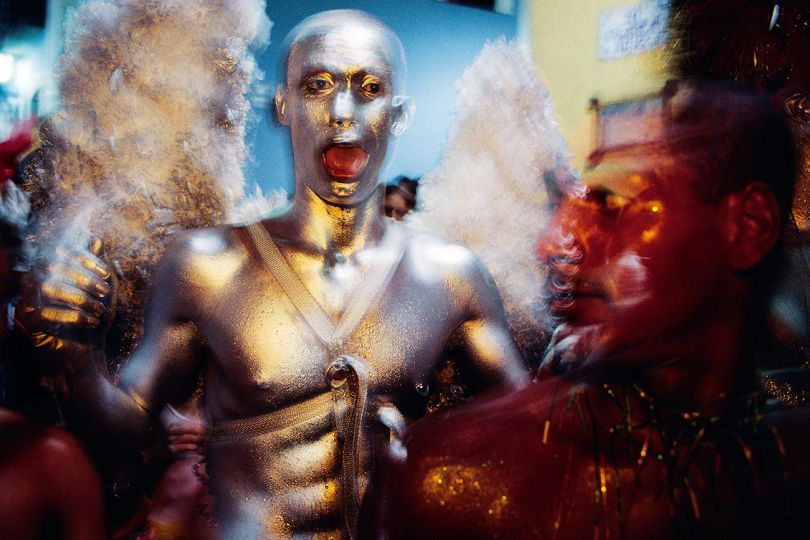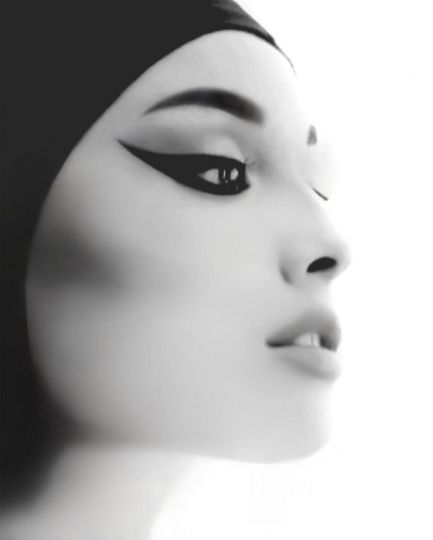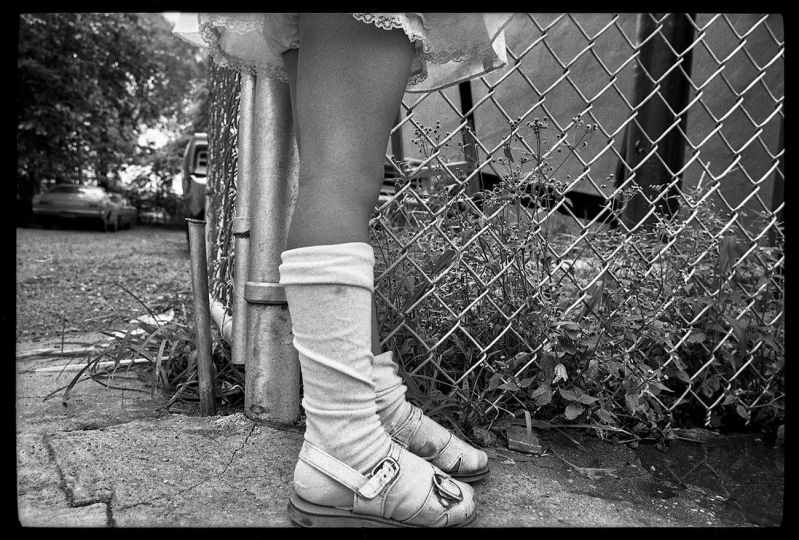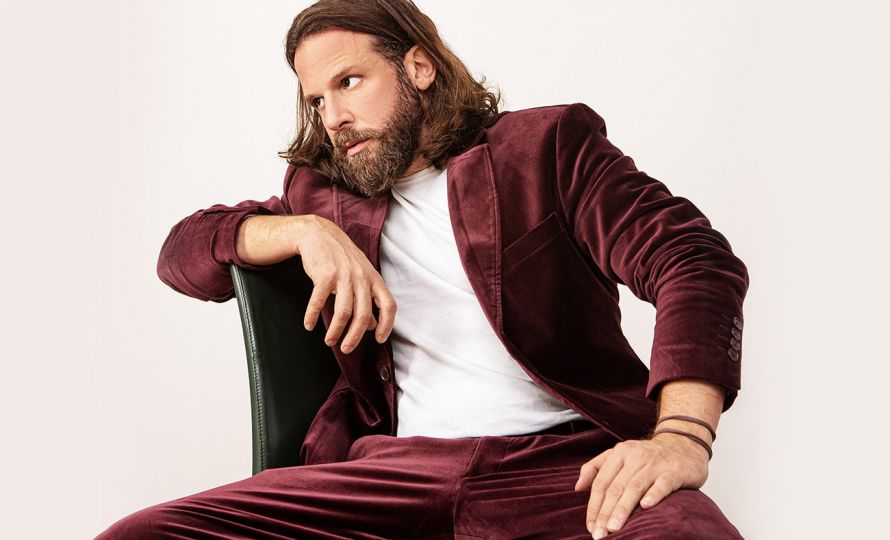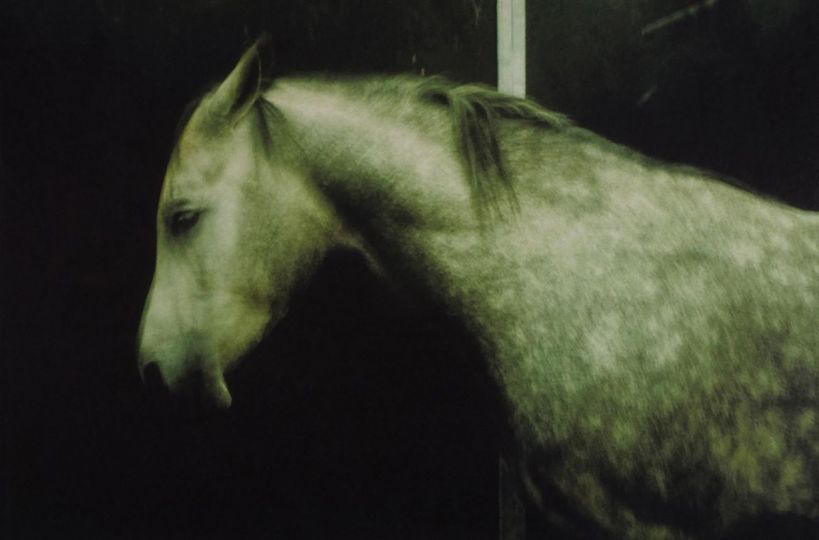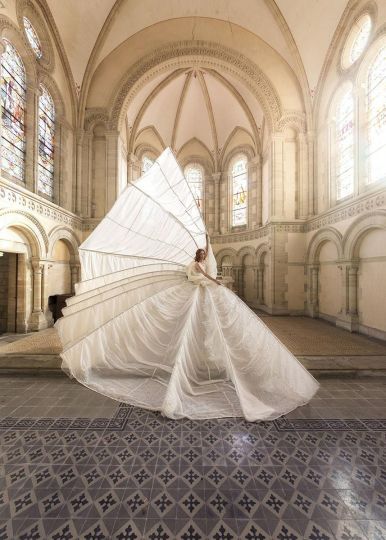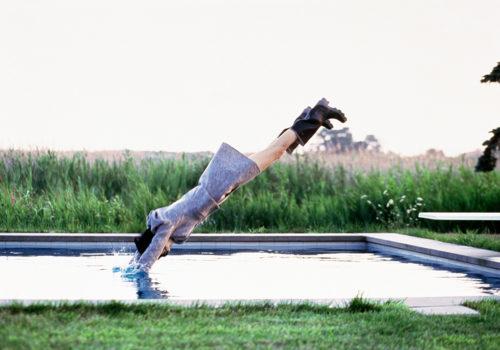Miami Beach Convention Center, Wednesday, Dec 4th, 2024
The quiet calm from Untitled spilled into the Convention Hall on Miami Beach. Arriving a bit earlier, I wandered upstairs, grabbed a spinach empanada, and settled into a chair on the roof deck. Here, Miami revealed its magic: crisp breezes swayed palm trees, their shimmering leaves catching the light and inviting a moment of stillness.
Right at 11am, I joined the line to enter the massive hall. To avoid staring directly at others, my eyes wandered towards their fashion. For some, the fair seemed as much about an expression of personal style as it was about art. A woman’s straight blue hair streaked with silver. A man’s textured jacket with laser cut petals. Gold leather moccasins. Fringe detailing on a denim dress. A red chiffon cape.
All around, the air throbbed with voices—French, Spanish, Portuguese, English, Russian, Korean, Mandarin—languages layering over one another, each competing to be heard.
What hit me first was a compelling installation which from afar looked like framed abstract paintings, but up close turned out to be made of photographic paper. I spoke with Peter at Galerie Buchholz about Wolfgang’s work.
Galerie Buchholz, Wolfgang Tilmans, Silver installation IV, 2008
Peter: “Wolfgang works in a number of different ways when he makes abstract photographs. The Silver series here is camera-less photography. These pieces are all made in the dark room using photosensitive paper, light, and the chemicals of the photo process. They are the original, unique pieces of paper he works with in the dark room, and they bare the traces of the process of developing them. So you can see there’s striated lines on this piece. That might have been a roller that has had chemicals that weren’t cleaned properly, and they leave marks of emulsion that remain on the surface. At certain times a fold or crease might become part of the process. The installation is laid out very specifically by the artist and is comprised of 23 unique elements.”
Galerie Buchholz, Yair Oelbaum, Untitled (citric repository), 2018
Peter: “Yair is a young artist and we’ll have our first show with him in January at our New York gallery. His photographs are quite mysterious. He doesn’t reveal so much information about the models (the constructed objects) he photographs. He uses elements that are between the organic and plastic, and you can’t quite understand the materiality of them. Is this resin? Is it plastic? Is that thread? Or part of plant matter? You’re left to wonder what the reality of it is. And as a photographic object he’s very specific about the frame. To me, it’s a poetic proposition.”
Teresa Margolles’ work illustrated a repetitive grid structure, a format that I also resonate with, within much of my work. Her piece also brought memories of making Offering, an installation done in collaboration with thecreativedestruction that recognized missing and murdered Indigenous women.
Galerie Peter Kilchmann, Teresa Margolles, El agua de la ciudad, Dallas, 2016
“The work El aqua de la ciudad, Dallas by Teresa Margolles documents the murders committed in Dallas in 2016, Margolles with volunteers visited each murder site, soaking the pavement with water, cleaning and returning the excess to an empty bucket. The entire process was repeated again and again, until the bucket was filled with ‘dirty’ water siphoned from the location. Each bucket for one homicide. The buckets were labeled with the location, victim’s name, age, and details about the murder. Most of the victims were non-white men. El agua de la ciudad, Dallas is related to Margolles’s project realized for the Dallas Biennial 2016.”
The next room I entered encased metal sculptures and photographs of bodies embracing them. Rafael from Piedras Galerias graciously talked more about the artist and her work.
Piedras Galeria, Jimena Croceri, Impossible Jewel series, 2024
Rafael: “Jimena is a multidisciplinary artist from Argentina. And her work is about opportunity, collaboration and communication. In her series Impossible Jewel, she created nine sculptures from bronze. She invited different people to join their bodies or try and find connections with the cavities within their bodies. It became a kind of performance with the piece and referenced the use of adornments for talismanic power in pre-Columbian Andean cultures. It’s called Impossible Jewel because you can’t wear them like the jewelry we know. In order to wear them, you have to maintain certain positions and connections with other people, finding the right location or placement of the piece with your body and/or others.”
Tensions and connections between bodies ran through Joanna’s work as well. I spoke with Matteo from Madragoa Gallery to learn more.
Madragoa Gallery, Joanna Piotrowka, Untitled, 2014-2022
Matteo: “Joanna Piotrowska is an artist from Poland. Her installation is a dialogue with family ties, social situations and constructions. Many of the pieces exhibited are from the series Frowst where she goes into the houses of people, looks at family pictures together and then restages them with the same family members, creating this new tension between the bodies.
Joanna Piotrowska (Warsaw, 1985) lives and works in London, UK.
In 2013, she obtained the MA in Photography at the Royal College of Art in London, and in 2009 completed the BA in Photography at the Academy of Fine Arts in Krakow, Poland. She had a recent show at ICA Philadelphia, and in 2022 she was included in The Milk Of Dreams, the 59th International Venice Biennial, curated by Cecilia Alemani.”
Another Polish artist’s installation which also touched me had an equally touching story about the gallery’s founder.
Gunia Nowik Gallery, Teresa Gierzyńska Installation (1979-1993)
Gunia: “This installation represents Teresa’s introspective exploration of female identity, using usually herself as the model in her key series About her. She performed in front of the camera in carefully staged situations, each paired with meaningful titles that reflect the experiences of many women. The images delve into themes such as self-analysis, abandonment, pressure, loneliness, and feelings of uselessness. Created decades ago in communist Poland, these works were radical for their time, especially given the limitations on resources and access to space and materials. Despite these challenges, Teresa never stopped working. The process of rediscovering her practice began around 10 years ago, with finally her first institutional retrospective at the Zachęta National Gallery of Art in 2021. Now 77, Teresa participated in a group show at the Walker Art Center last year which is now traveling to the Vancouver Art Gallery, and her work has been acquired by collections such as the Art Institute of Chicago, Centre Pompidou, Erste Bank in Vienna, and Kunsthaus Zürich. I’m happy she can experience this deserved recognition of her work after so many years.
Discovering Teresa’s emancipation story in her practice helped me realize that my way forward was also to liberate myself from past experiences that had held me back from pursuing the work I truly wanted to do. During the pandemic, I came to a turning point and decided to change my life. That’s when I founded my own gallery, built on a horizontal structure with our team of five women. As one of the youngest galleries at the fair, having been established just three years ago, we’re thrilled to be exhibiting for the first time at Art Basel Miami with a solo presentation by Teresa Gierzyńska.”
Other familiar photographic works included:
Robert Mapplethorpe, American Flag, 1977, Gladstone
LaToya Ruby Frazier, Grandma Ruby and Me, 2005, Gladstone Andreas Gursky, Stieiff, Höchstatt, 1991, Sprüth Magers
Jeff Wall, Insomnia, 1994, White Cube
Gillian Wearing, Self Portraits (2023), Regen Projects
Thomas Struth, Sorghum, Danforth Plant Science Center, 2017, Marian Goodman Carrie Mae Weems, Laying on the Hands, 2002, Galerie Barbara Thumm Vanessa Beecroft, VB62, 003, VB 2008, Lia Rumma
CYJO
About the writer: CYJO is a Korean American artist based in Miami whose work, since 2004, focuses on identity of person and place, exploring existing constructions of culture and categorizations. She is also co-founder of thecreativedestruction, an art collaborative with Timothy Archambault, and is a long-time contributor to L’Oeil de la Photographie. www.cyjostudio.com @cyjostudio

